A tremolo effect consists of amplitude modulation, which cyclically raises and lowers the signal level. Guitarists usually utilize a pedal to get this effect, although a similar effect may be achieved by rapidly adjusting the volume knob on the instrument or amplifier. However, the best tremolo pedal is able to create many variations of tremolo sound (chops, wobbles, purrs, etc.).
The tremolo pedal is one of the oldest guitar pedals ever. The first one appeared on the market in 1941. However, before its appearance, the tremolo effect was reached with the help of special amps which were supplied with the built-in feature that automatically modulated the volume.
The tremolo effect is used for the creation of some dramatic musical effects. It can be heard in the musical compositions of such popular artists like Johnny Marr (The Smith), Link Wray, Marc Ribot, Duane Eddy, and Jonny Greenwood. As for modern music, the tremolo effect is used in Green Day’s “Boulevard Of Broken Dreams”, for example.
Tremolo pedals are still among the most popular nowadays since they are inexpensive and easy to use while having a major impact on the tone of music.
It can be tough to understand what you should look for when choosing the best tremolo pedal. This way, we offer you our top picks: read about modern, vintage-inspired, minimalist, and multifunctional models and make your choice. To shed more light on how the tremolo pedal works, there is also an informative buyer’s guide which will explain about this device.
Tremolo Pedal Reviews
Fender
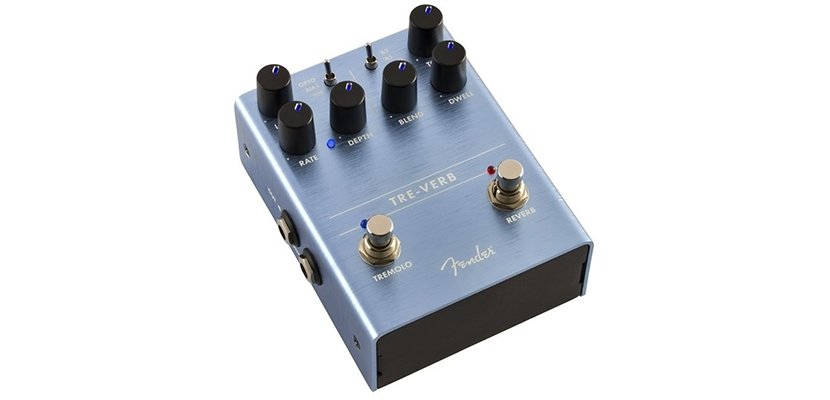
The present model from Fender is a reverb tremolo pedal that can produce both tremolo and reverb effects. The pedal comes in 8 different colors to suit your preferences: three different hues of green, two different shades of blue, silver, grey, and black.
It has 6 control knobs. The Level knob adjusts the tremolo output level. The Rate knob allows setting the speed. The Depth knob allows adjusting the intensity of the tremolo. The Tone knob controls the number of high frequencies. The Blend knob controls the amount of reverb. The Dwell knob adjusts the amount of reverb sustain.
Except for these knobs, this tremolo pedal also has two three-way toggles. The first one allows choosing between three different tremolo voices: Opto (for optical tremolo), Bias (for tube tremolo), and HM (for a more harmonic tremolo sound). The second one offers three different reverb voices: ‘63 (to get similar to Fender’s standalone Reverb Tank sound), ‘65 (for classic blackface-amp reverb sound), and Plate (for splashy reverb sounds that are great for studio recordings).
A path switch is located on the top side of the pedal and allows you to select the order in which the tremolo and reverb effects are applied. Two footswitches to control the amount of both effects are located on the bottom part of the face panel. The tremolo effect can also be controlled with a tap tempo.
The pedal also has two LED indicators that show the on/off status of the reverb and tremolo effects (blue for tremolo and red for reverb), the rate LED indicator (located between Rate and Depth knobs) which blinks at tremolo tempo.
There are two stereo inputs and outputs. This model is supplied with a standard center-negative 9V DC jack.
Despite the number of controls, the pedal is only 3.75 x 4.9 x 2.5 inches so it fits in the palm of your hand and weighs 1.2 lbs.
Pros
- There is a LED kill switch with the help of which you can turn off all the LEDs if they bother you.
- It’s possible to either mix the tremolo and reverb effects or use them on their own.
- The right and left input jacks are very multifunctional: they work with any guitar (electric, bass, acoustic), keyboards, and other instruments.
Cons
- The knobs are too small, being located too close to each other.
- The pedal may seem not very responsive.
Video Fender
BOSS TR-2
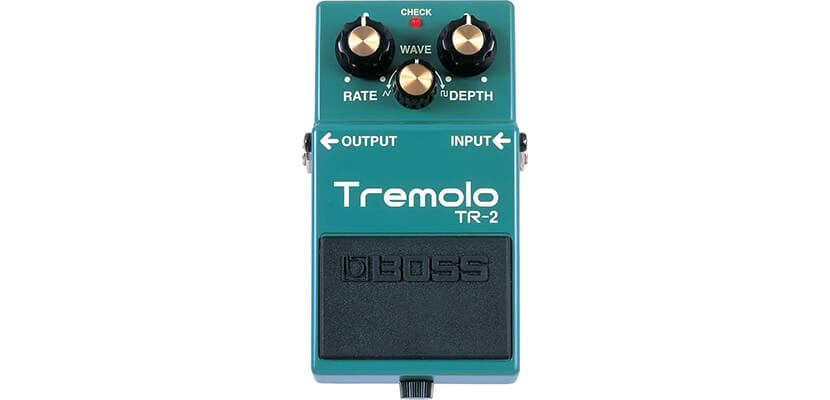
This model from BOSS can possibly be the best cheap tremolo pedal in terms of simplicity. It has only 3 control knobs but still able to deliver classic vintage tremolo. The Rate knob allows adjusting the speed of the tremolo. With the Wave knob, you can adjust the LFO waveform, going from smoother volume changes to more dramatic ones. The Depth knob adjusts the depth of the tremolo. On the very top of the pedal, there is a red LED light which indicates whether the effect is on or off and also shows the battery charge level.
The output jack for the amplifier is located on the left side of the BOSS TR-2. The input jack on the right of the pedal is designed for electric guitars and also works as a power switch. When you connect the cable into the input jack, the unit turns on, and when you remove the cable, the device turns off. So you have to be sure that the cable is disconnected when you don’t use the pedal.
This BOSS tremolo pedal can be powered by batteries. It also has a DC input jack, located on the top side of the pedal. It uses a specified AC adaptor (PSA series) which, however, should be bought separately.
The dimensions are 2.8 x 5 x 2.3 inches and it weighs less than a pound.
Pros
- The pedal comes with a 6F22/9V carbon battery which works for 13 hours on one charge.
- The BOSS TR-2 owner’s manual includes 4 setting samples for beginners.
- This pedal is backed by a five-year guarantee from BOSS.
Cons
- It is hard to get some complicated effects using this pedal.
- There are issues with volume dropping when the pedal turns on.
Video BOSS TR-2
JHS Kodiak
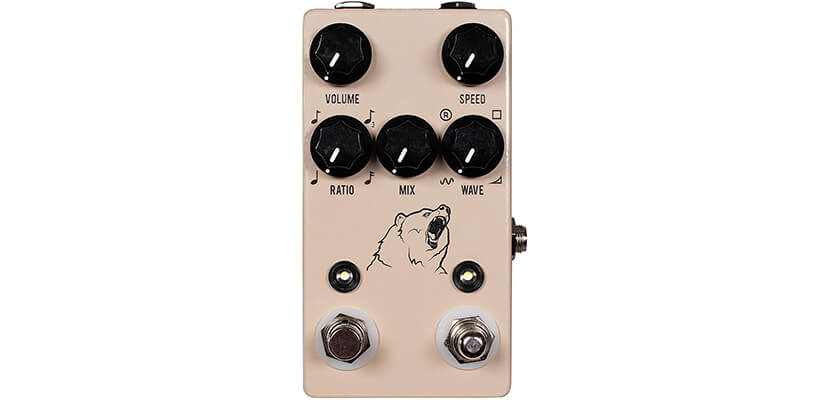
This tremolo guitar pedal from JHS features 5 control knobs, 4 different wave patterns, and an onboard tap tempo which will allow you to create a loud tremolo growl. The pedal is based on classic Vox and Black Face tremolo sounds, bringing vintage sounding.
The Volume control is used to set the volume. The Speed knob allows setting the speed of the tremolo (which you can also set with the tap tempo switch). The color of the LED matches to the color of the speed knob, allowing you to see which speed is selected. The Mix knob on this pedal is not standard as it controls how deep the tremolo will be (from clean to wet sound). The Ratio knob gives you the ability to get faster speeds with fewer taps. You can select from the quarter, dotted eighth, eighth, or triplet note divisions. The Wave knob allows switching between four different variations: Sine, Rhythmic, Square, and Ramp. When the tremolo is turned off, the tone is preserved thanks to a true bypass switch.
This tap tempo tremolo pedal has a tap/expression jack on its right side which allows plugging in an external tap tempo or an expression pedal to control the speed of the tremolo. There is also one 1/4” input jack on the top right side of the pedal, and one 1/4” jack on the top left side of the pedal. The pedal has a standard center-negative 9V DC jack.
The Kodiak weighs 0.63 lbs and has 2.6 x 4.8 x 1.6 inches.
Pros
- This pedal allows setting 2 different tremolo speeds and switch between them with a footswitch.
- The tremolo effect provided by this pedal is transparent and low-noise.
- The effect doesn’t introduce any noticeable coloration to the direct signal.
Cons
- The LED lights are not stable and can quickly go off.
- The knobs are a bit harsh to turn.
Video JHS Kodiak
JHS Tidewater
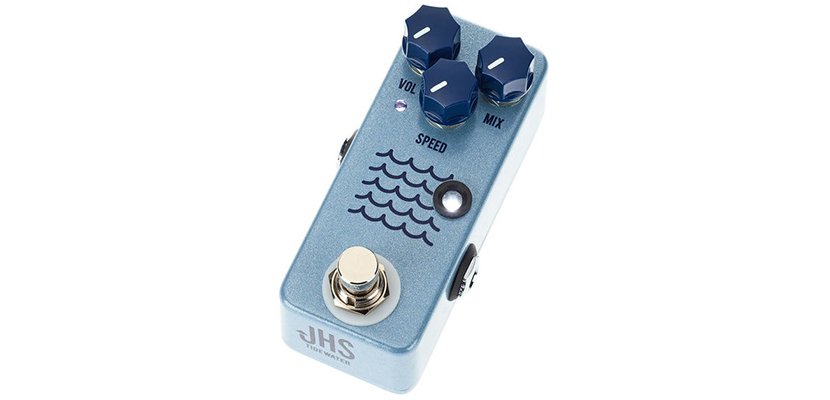
This is one of the best tremolo pedals in terms of simplicity. It has only 3 basic control knobs and a very small footprint (3.6 x 1.5 x 1 inches). It’s an amp-like pedal that has vintage character, allowing you to create some classic, warm tremolos.
The Volume knob allows adjusting the overall volume of the unit, you can use it to set the volume or to boost your signal. The Mix knob controls the depth of the tremolo. The Speed speed slider allows you to control the speed of the effect.
Except for these 3 knobs, this JHS tremolo pedals also has 3 small internal dip switches inside the pedal (on the back). When all of them are lowered, the tremolo’s speed will return to the default setting. When they are in the up position, the speed is half of the standard mode, giving you a slower effect. The tremolo moves are indicated by white LED light (located next to the speed knob). Plus, there is also an on/off LED indicator.
The pedal has one 1/4” input jack and one 1/4” jack. It weighs 0.34 lbs and uses center-negative 9V DC power.
Pros
- All the controls on this pedal are very accurate.
- The Mix control can also be used as a warm pre-amp boost.
- Although the pedal is simple in design, it nevertheless enables the user to create some really dramatic effects.
Cons
- The control knobs are located too close to each other.
- It’s hard to use this pedal in the poorly lit environment as the LEDs are too dim.
Video JHS Tidewater
Chase Bliss Audio Gravitas
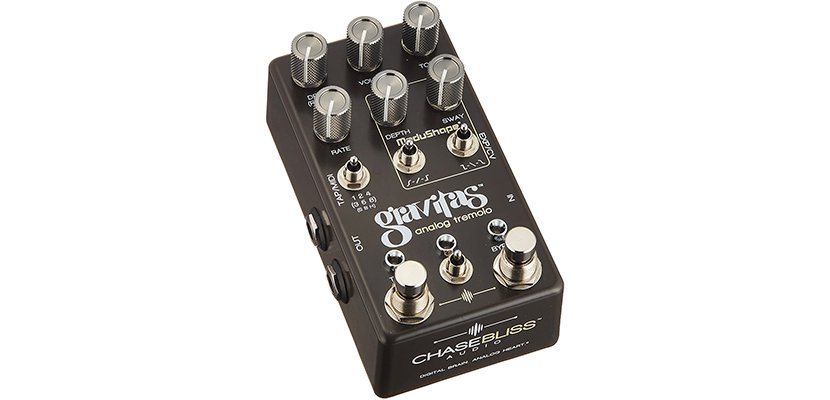
This multi-purpose analog tremolo pedal lets you produce a wide variety of tremolo sounds.
The Drive (Ramp) knob allows reaching a clean and transparent boost. Plus, it also controls the ramp time. The Volume knob on this pedal is not standard: it should be dimed, as the level of the tremolo is set with the Drive control. Use the Tone knob to adjust the tone of the effect: from bright to dark. The Sway knob allows controlling the tremolo modulation. The Rate and Depth knobs perform their standard functions. The pedal also has the bypass stomp to activate or bypass the effect.
There is also 1/2/4 (3/6/8) (S/B/H) toggle switch which controls tap divisions and allows switching between three types of tremolo: S = standard, H = harmonic, and B = both for them simultaneously. The pedal also has 2 wave toggles (left and right) to switch between square, sine, and triangle waveforms. The lower toggle is designed to recall the presets: the LED above the toggle goes dim when you recall the preset and blinks when your preset is saved.
The pedal has a mono input jack and TRS jack. It operates with a 9V battery or standard 18V DC center negative adapter.
The pedal’s dimensions are 2.2 x 2.4 x 4.7 inches and weighs almost one pound.
Pros
- The pedal comes with a velvet bag and wooden case.
- The dip switches in the left bank allow controlling the pedal’s parameters via ramping or an expression pedal.
- The tremolo sound is extremely similar to that of the original pedal from the 1960s.
Cons
- The pedal is pretty complicated to use even for experienced players.
- It may add some noise to the signal.
Video Chase Bliss Audio Gravitas
JOYO JF-09
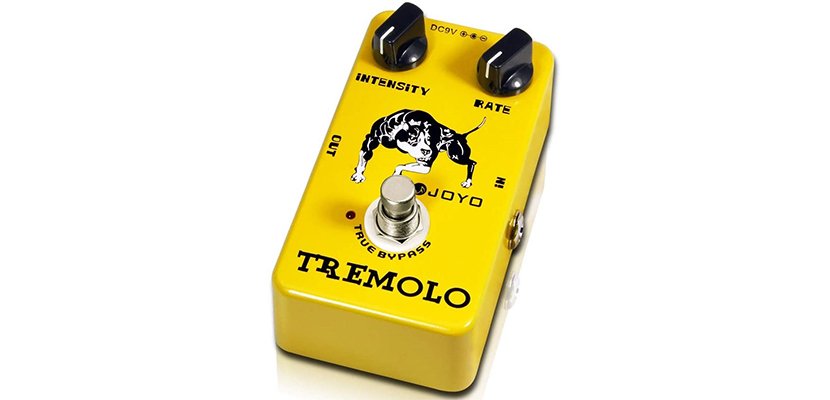
There are just two settings on this JOYO tremolo pedal — Intensity and Rate — yet they allow you to easily alter the tremolo’s tone and feel. It delivers similar to classic tube amplifiers sound. Besides, it’s a very cheap tremolo pedal, so it definitely won’t make you break the bank to get some vintage sounding tremolo.
The intensity knob allows adjusting the mixing ratio of both delayed and original signals. The Rate knob works to adjust the speed. The pedal has true bypass to minimize tone loss. There is also a red LED light which indicates the power status.
Yellow and red pedals are offered; the pedal features an all-aluminum alloy body finished in varnish. It weighs 0.73 lbs. It can operate with the help of a 9V battery or a 9V DC adaptor.
Pros
- The pedal is very easy to use so it’s suitable for beginners.
- The transition between settings is smooth.
- The pedal uses a similar optical circuit that was used in original Fender amps.
Cons
- Despite having only two controls, the pedal is not compact (4.6 x 6.8 x 1.4 inches).
- It doesn’t sound good at slow settings.
Video JOYO JF-09
Buyer’s Guide
Working Principles of Tremolo Pedal
As soon as you turn the tremolo pedal on, it creates a wave: sine, square, or triangle one. Some pedals offer only a certain type of wave, and the others give the opportunity to create multiple types of waveforms. Its circuitry begins to create a wave carrier signal, changing your signal’s amplitude. In simple words, the volume reduces to a minimum and then becomes intensive again.
Today, there are a lot of circuits that are able to create a tremolo effect. The pedal may vary the amplitude of the sound wave, producing a tremolo effect, since one of them is dependent on the voltage-controlled amplifier. Such a circuit is really simple, reliable, and stable.
The modern tremolo pedals (and handmade pedals) as a rule, use a low-frequency oscillator (LFO) circuit which allows for a compact size, wider functionality, and cheap price. It usually consists of high and low pass filters. To create a tremolo effect, it changes the signal’s phase. As the name implies, the low-frequency oscillator is designed to work at low frequencies, so the range of preset values usually lies in the range from 0.1Hz to 10Hz. Its peak values affect the volume while the values in between affect the speed.
The main purpose of the LFO is the wave formation.
Types of waveforms
The sine wave is one of the simplest ones and was used in the first tube tremolo pedals. This type of wave doesn’t have any harsh lines, so it has a soft, subtle, and smooth sound. It’s created thanks to the modulation of transistors or power tubes. In some tremolo pedals, this form can be blurred, resulting in a not so pronounced tremolo effect.
The square form is a modern type of form and it sounds quite tough and abruptly as the sound may completely disappear at some point. The square wave creates a pulsating tremolo, producing a dramatic effect. At high-speed value, it reminds the sound of helicopter chops.
The triangle wave is one of the classic ones. The triangle shape means that both peaks and lows will be very pronounced and it doesn’t matter how you play. It slices through the music, creating an unusual effect. The triangle wave is something between the sine and the square wave. However, it’s not as blurry as a sine wave and not as sharp as a square wave. The triangle wave was used in first optical tremolo pedals, where it sounded smother. In the modern pedals, it’s more pronounced.
There are several additional waveforms in addition to these three, although they are not as frequent. For example, the sawtooth wave: it reminds the triangle wave, but the peaks and lows are much more pronounced as the ups and downs occur more often. There is also a sharkfin type of wave, which, basically, the same as the sawtooth.
Rate and depth controls
The rate control is responsible for the speed at which the sound changes its volume and it always requires some fine tuning as it should match the tempo of the song you are playing. This is one of the main tremolo parameters, so it’s present in almost all the pedals. In some of them, the frequency of volume changes can be set with the help of tap tempo.
The depth control allows adjusting the depth of the effect: how quiet the signal will be between the peaks of the wave, from light flicker to complete silence. Lower depth values help create a more subtle effect while higher values are more dramatic.

Hi everyone! I’m Thomas Moody, also known as Guitarzan.
